#sensor-enabled solutions
Explore tagged Tumblr posts
Text
How Data Analytics Enhances IoT Development for Smarter Business Solutions

#Introduction:#The combination of data analytics and the Internet of Things (IoT) is opening the door to more intelligent and effective business solutions#businesses can collect#evaluate#and act on real-time data#which improves customer experiences#lowers operating costs#and streamlines decision-making. This blog will discuss how data analytics enhances IoT development to provide more intelligent solutions a#Understanding the Core of IoT and Data Analytics#IoT Development involves creating systems and devices that communicate with each other over the internet#collecting data to automate processes and respond to changing environments. Sensors embedded in IoT devices capture enormous volumes of dat#from environmental conditions and machinery performance to user behavior and logistics data. However#this raw data alone has limited value until it’s processed and analyzed.#This is where Data Analytics comes into play. By analyzing IoT data#businesses can derive actionable insights#identifying trends#patterns#and anomalies. Data Analytics converts unstructured data into meaningful information#enabling businesses to make data-driven decisions.#The Role of Data Analytics in IoT Development for Smarter Solutions#Data Analytics is not just an add-on to IoT but a transformative element that enhances the functionality and intelligence of IoT solutions.#Real-Time Monitoring and Predictive Maintenance#Predictive Maintenance is crucial in sectors like manufacturing and energy#where machine downtime can lead to significant losses. IoT sensors embedded in machinery continuously collect data#which Data Analytics processes to predict equipment failures before they happen. This predictive approach minimizes disruptions#extending machinery life and reducing repair costs.#Enhanced Decision-Making Through Data Visualization#For organizations#it’s vital to not only collect data but also interpret it effectively. Advanced Data Analytics provides data visualization tools that trans#easily understandable formats. These insights enable business leaders to make quicker
0 notes
Text

Empowering the Future: Cutting-Edge IoT Solutions for a Connected World
HelixSense offers innovative IoT solutions, seamlessly integrating smart devices to optimize operations across industries. Our cutting-edge technology harnesses the power of the Internet of Things, enabling real-time data insights and efficient automation. Elevate your business with HelixSense's tailored IoT solutions for enhanced connectivity and productivity.
0 notes
Text

For the Benefit of All: Assistive Tech Developed from NASA Tech
What do modern cochlear implants and robotic gloves have in common? They were derived from NASA technology. We’ve made it easier to find and use our patented inventions that could help create products that enhance life for people with disabilities.
October is National Disability Employment Awareness Month, which highlights the contributions of American workers with disabilities – many of whom use assistive technology on the job. Take a look at these assistive technologies that are NASA spinoffs.
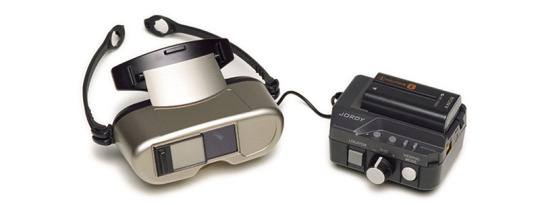
Low-Vision Headsets
The Joint Optical Reflective Display (JORDY) device is a headset that uses NASA image processing and head-mounted display technology to enable people with low vision to read and write. JORDY enhances individuals’ remaining sight by magnifying objects up to 50 times and allowing them to change contrast, brightness, and display modes. JORDY's name was inspired by Geordi La Forge, a blind character from “Star Trek: The Next Generation” whose futuristic visor enabled him to see.

Cochlear Implants
Work that led to the modern cochlear implant was patented by a NASA engineer in the 1970s. Following three failed corrective surgeries, Adam Kissiah combined his NASA electronics know-how with research in the Kennedy Space Center technical library to build his own solution for people with severe-to-profound hearing loss who receive little or no benefit from hearing aids. Several companies now make the devices, which have been implanted in hundreds of thousands of people around the world.

Robotic Gloves
Ironhand, from Swedish company Bioservo Technologies, is the world’s first industrial-strength robotic glove for factory workers and others who perform repetitive manual tasks. It helps prevent stress injuries but has been especially warmly received by workers with preexisting hand injuries and conditions. The glove is based on a suite of patents for the technology developed by NASA and General Motors to build the hands of the Robonaut 2 humanoid robotic astronaut.

Smart Glasses
Neurofeedback technology NASA originally developed to improve pilots’ attention has been the basis for products aimed at helping people manage attention disorders without medication. The devices measure brainwave output to gauge attention levels according to the “engagement index” a NASA engineer created. Then, they show the results to users, helping them learn to voluntarily control their degree of concentration. One such device is a pair of smart glasses from Narbis, whose lenses darken as attention wanes.

Anti-Gravity Treadmills
A NASA scientist who developed ways to use air pressure to simulate gravity for astronauts exercising in space had the idea to apply the concept for the opposite effect on Earth. After licensing his technology, Alter-G Inc. developed its anti-gravity G-Trainer treadmill, which lets users offload some or all of their weight while exercising. The treadmills can help people recover from athletic or brain injuries, and they allow a safe exercise regimen for others with long-term conditions such as arthritis.
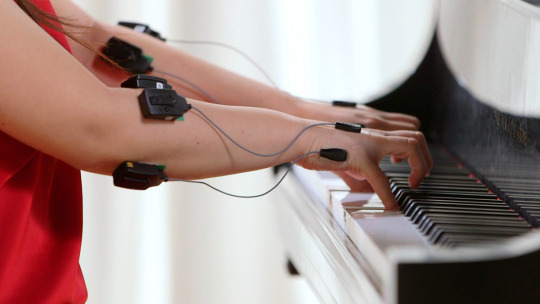
Wireless Muscle Sensors
Some of the most exciting assistive technologies to spin off may be yet to come. Delsys Inc. developed electromyographic technology to help NASA understand the effects of long-term weightlessness on astronauts’ muscles and movements. Electromyography detects and analyzes electrical signals emitted when motor nerves trigger movement. Among the company’s customers are physical therapists developing exercise routines to help patients recover from injuries. But some researchers are using the technology to attempt recoveries that once seemed impossible, such as helping paralyzed patients regain movement, letting laryngectomy patients speak, and outfitting amputees with artificial limbs that work like the real thing.
To further enhance the lives of people with disabilities, NASA has identified a selection of patented technologies created for space missions that could spur the next generation of assistive technology here on Earth.
Want to learn more about assistive technologies already in action? Check out NASA Spinoff to find products and services that wouldn’t exist without space exploration.
Make sure to follow us on Tumblr for your regular dose of space!
#NASA#space#tech#technology#spinoff#robotics#physical therapy#disability#disabled#accessibility#a11y#inventions
844 notes
·
View notes
Text
Why don't cars have a dash board warning light alerting you when a taillight or headlight is out? You normally don't know until you get pulled over by a cop. Even if you check them before each trip they sometimes burn out while on the trip.
The absence of universal dashboard warnings for burnt-out exterior lights (headlights, taillights, etc.) is a mix of cost, design priorities, and technological limitations—but solutions exist. Here’s why most cars lack this feature and what drivers can do:
Why Most Cars Don’t Warn You Cost-Cutting by Manufacturers:
Adding a monitoring system for every bulb requires additional wiring, sensors, and software, which automakers often omit to keep prices low, especially in budget vehicles.
Example: A $20 circuit to detect bulb failures adds up to millions in production costs across a car model’s lifespan. Simpler Electrical Systems:
Older cars use basic circuits where a burnt bulb doesn’t disrupt the electrical flow (unlike a blown fuse). Modern CAN bus systems can detect failures but aren’t always programmed to alert drivers. Assumption of Manual Checks:
Manufacturers assume drivers will notice via:
Reflections (e.g., light bouncing off garage walls).
Dashboard icons for specific systems (e.g., brake light warnings tied to the brake pedal circuit). Regulatory Gaps:
The U.S. doesn’t mandate bulb-out warnings, though the EU requires rear light failure alerts in newer cars (via ECE Regulation 48).
Cars That Do Have Warnings Luxury/Modern Vehicles: Brands like BMW, Mercedes, and Tesla include bulb monitoring systems in higher trims.
LED Lighting: Many EVs and hybrids with full LED setups (e.g., Ford Mustang Mach-E) self-diagnose faults since LEDs rarely fail abruptly.
Aftermarket Kits: Products like LightGuardian (50–100) plug into taillight circuits and trigger an alarm if a bulb dies.
Why Bulbs Burn Out Mid-Trip Halogen Bulbs: Prone to sudden failure due to filament vibration or temperature swings.
Voltage Spikes: Poor alternator regulation can surge power, killing bulbs.
Moisture/Corrosion: Water ingress in housings causes shorts over time.
Practical Solutions for Drivers Retrofit Your Car:
Install LED bulbs with built-in failure alerts (e.g., Philips X-tremeUltinon).
Use Bluetooth-enabled bulb holders (e.g., Lumilinks) that notify your phone. Routine Checks:
Nightly Reflection Test: Park facing a wall and check light patterns.
Monthly Buddy Check: Have someone press brakes/turn signals while you inspect. Legal Workarounds:
In regions requiring annual inspections (e.g., EU, Japan), mechanics flag dead bulbs.
Use dual-filament bulbs for redundancy (e.g., a brake light that still works as a taillight if one filament fails).
Why It’s Likely to Improve LED Adoption: Longer-lasting LEDs (25,000+ hours) reduce failure rates.
Smart Lighting: New cars with matrix LED or laser lights often self-diagnose.
Consumer Demand: Aftermarket alerts (e.g., $30 Wireless Car Light Monitor) are gaining traction.
Bottom Line
While universal bulb-out warnings aren’t standard yet, technology and regulations are catching up. Until then, proactive checks and affordable aftermarket gadgets can save you from a traffic stop. 🔧💡
Pro tip: If your car has automatic headlights, toggle them to “off” occasionally to manually check all lights in a reflection.

#led lights#car lights#led car light#youtube#led auto light#led headlights#led light#led headlight bulbs#ledlighting#young artist#led light bulbs#car culture#race cars#classic cars#car#cars#cartoon#suv#porsche#truck#carlos sainz#supercar#automobile#headlight bulb#headlamps#headlamp#headlight#aftermarket new lamp#car lamp#lamp
7 notes
·
View notes
Text

Stretchable transistors used in wearable devices enable in-sensor edge computing
Organic electrochemical transistors (OECTs) are neuromorphic transistors made of carbon-based materials that combine both electronic and ionic charge carriers. These transistors could be particularly effective solutions for amplifying and switching electronic signals in devices designed to be placed on the human skin, such as smart watches, trackers that monitor physiological signals and other wearable technologies. In contrast with conventional neuromorphic transistors, OECTs could operate reliably in wet or humid environments, which would be highly advantageous for both medical and wearable devices. Despite their potential, most existing OECTs are based on stiff materials, which can reduce the comfort of wearables and thus hinder their large-scale deployment.
Read more.
#Materials Science#Science#Transistors#Computing#Electrochemistry#Electronics#Organic materials#Flexible electronics#Wearable technology
16 notes
·
View notes
Note
This might sound like a weird question, but have you ever come across a camera with a Bird Watching setting? I have an Olympus SP-800UZ and one of the modes it comes programmed with is literally called that, for taking pictures of birds in the wild.
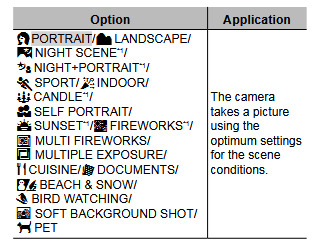
As someone whose special interest is birds, I love this setting and use it a LOT, but I've never been able to find another camera with a setting like it, and at some point I told myself I didn't want to replace the camera until I could find one with a similar setting.
The reason I ask is because I've been following for a while, and I've come to respect your opinions on photography.
I tried researching your camera and figuring out what exactly the bird watching mode does and even the official manual did not say. If I were to guess, it just sets the camera up with certain parameters that are usually ideal for photographing birds, but I don't think it does anything special that other cameras can't do. You would just have to set a different camera up to those parameters rather than the camera doing it for you.
If I were to guess, it probably enables a certain autofocus mode for small subjects and limits how slow the shutter speed can go so you don't get motion blur when very zoomed in.
However, I know exactly which features are important to get good bird photos, so as long as the camera has the following features, you don't really need a dedicated bird mode. Though if a camera has a "pet mode" it would probably work similarly to the bird mode you are used to.
Most important bird photography features...
Good autofocus
Good zoom range
Image stabilization (Either optical or sensor, not digital)
Autofocus has come a long way in the last few years. It's difficult to assess the autofocus from specifications alone, so you will probably need to rely on reviews to know if the camera locks in on subjects well. Some cameras have pet and wildlife autofocus features that can be very helpful in tracking smaller subjects like birds. So I would look out for any camera that has a pet autofocus mode or a review that says it locks onto smaller subjects well—even if they don't mention birds. If it can lock onto a chihuahua, it can usually do so with a bird too.
Birds and wildlife in general tend to get spooked easily and it is often difficult to get close without them running or flying away. So having a longer zoom range can really help you keep your distance and not startle your subject. I would say the minimum focal length for getting good bird shots is around 300mm (on a full frame camera). Some cameras only quantify their zoom by magnification (20x, 30x, 40x, etc.) and don't really say what that is in relation to. So focal length is a better metric to assess how zoomy a lens is. 10-35mm would be wide angle. 50mm is about like our eyes. 100mm is slightly telephoto. And 300mm and above would be very telephoto.
You may need to google the focal range equivalent to a full frame 35mm camera. So you would search "[camera model] 35mm equivalent focal range" to figure that out. And as long as it goes past 300mm, it might be a good candidate for birding.
When you have a camera that zooms in that far, any movement will be exaggerated—especially if you have naturally shaky hands. Not only can that introduce motion blur into your images, but it can make it very difficult to track your subject. Looking through the viewfinder will result in a wiggly mess and you won't know what you are pointing the camera at.
Image stabilization helps negate that exaggerated movement.
There are 3 kinds of stabilization. First is optical, which is built into the lens with a floating glass element. Then there is sensor stabilization (often called IBIS for "in-body image stabilization") which allows the sensor to shift and move to counteract any motion introduced by your hands. And the last form is digital stabilization which is done using the camera's software.
The first two are physical solutions that can adjust on the fly much like a chicken's head.

The digital solution is mostly just fancy image cropping. It zooms in a tiny bit on your image and then aligns a continuous crop to give the appearance of a stable image.
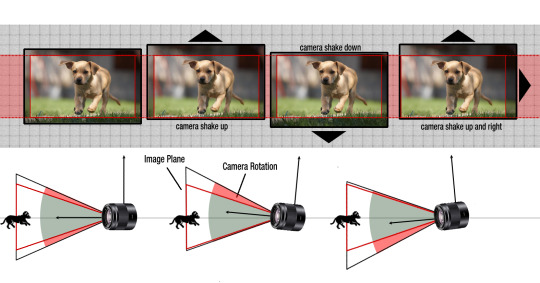
The lens and the sensor are still a jiggling mess, but this constant cropping allows you to see the illusion of a stable image in your viewfinder and in the videos you take. And while this is very helpful for tracking subjects and capturing video footage, it will not help you negate motion blur—which is why the other two methods are preferred for still photography.
Bigger cameras can often forego stabilization because the zoom lenses are bigger and heavier and don't shake as much and they let in a lot more light so you can raise your shutter speed to freeze motion. It's still nice to have, and if you have IBIS and optical stabilization combined on a big camera you can almost take pictures in the dark without camera shake, but all of those conveniences can get costly.
The camera you have now is called a "bridge" camera or a "superzoom". These are (relatively) inexpensive cameras that use a smaller smartphone-style sensor but with a more classic camera body surrounding it and a non-changeable lens. Small sensors have one big advantage where if you put a zoom lens in front of them, they can see from Alaska to Russia.
For instance, your camera has an 840mm equivalent lens. That is near telescopic.
For reference, this is what an 800mm lens looks like for a full frame professional camera.
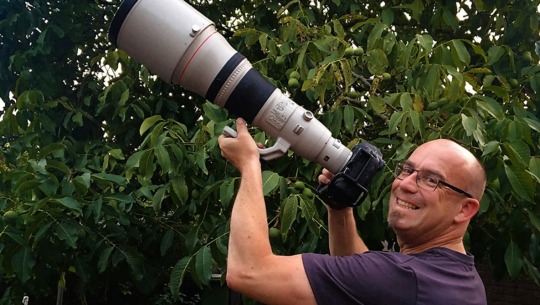
It weighs 10 pounds and costs about $13,000.
Granted the image quality of that lens is in another universe compared to your superzoom, but if you are mostly interested in documenting the birds you are encountering, a superzoom is a neat tool to have. It's like digital binoculars.
So I guess the question is, do you just want to document your bird adventures or do you want to delve into artistic bird photography?
You can upgrade to a nicer superzoom and get some improved clarity and ease-of-use features, which is totally valid. You could even get a "premium" superzoom that can do artistic bird photography in ideal lighting conditions.
Or if you go with a more professional interchangeable lens camera system (ILC), you can achieve some stunning artistic photos like these...



Freezing a bird midflight while catching a fish is just not really feasible with a basic superzoom.
Let's talk about the advantages and disadvantages of a superzoom bridge camera as compared to a more professional ILC setup.
Superzoom Pros
No learning curve. These cameras are designed for novice photographers and have very good automatic functions. You can pretty much pull them out of the box and start taking pictures without knowing the fundamentals of photography.
Incredible zoominess. You can get amazing zoom power for a fraction of the price.
Budget friendly. The top of the line superzoom camera is still only about $1500 as compared to the top of the line mirrorless ILC (for wildlife) which is $6500 *without* a lens. And the lower to mid range superzooms are even more affordable, especially if you consider used options.
Superzoom Cons
Noisy images in low light. These cameras are mostly suited for bright sunny days. The small sensors and cheaper lenses do not capture very much light. In more challenging lighting situations you will tend to get very noisy images due to using a high ISO to compensate.
Inconsistent image quality. Under the best of circumstances, you can get some really beautiful photographs. But when you push the camera to its extremes, the image quality can start to deteriorate. Low light causes noise. The more you zoom in, the softer your images will get. Low megapixels limit your options to crop in on far away subjects—which is often an issue with wildlife.
Deep depth of field. A lot of bird photographers like using shallow depth of field to blur the background so the bird really stands out in the photo. Small sensors can have a very hard time blurring the background unless the subject is quite far away and you are zoomed all the way in. But when you are all the way zoomed in, the image can get soft and lack detail. So you trade image quality for a blurry background.
Lack of professional features and accessories. There are many advanced features that can make bird photography much easier. Some cameras have advanced motion tracking that can allow you to capture birds in flight. The latest generation can even track a tiny bird's eye. There are also accessories that are only made for ILCs. Like motion activated shutter triggers that will take a picture of a bird automatically if you set up a camera near a feeder. There are flashes that work at very long distances. You can get camouflage skins for your lenses so the birds can't see you. Stuff like that.
ILC Pros
Lower image noise. With a bigger sensor and better lenses you can shoot with a very low ISO in good light and get incredibly clean noise-less images.
Better high ISO performance. If you are in low light, you can increase the ISO and still get a very good image. The noise on an ILC is much less distracting and easier to deal with—especially with advanced noise reduction software.
Background blur is easy. Due to the much larger sensor and telephoto lenses, almost every telephoto image will have beautiful blurry backgrounds no matter how small the aperture is.
Sharper, faster lenses. The lenses are much sharper and let in a lot more light. The quality of the image does not decrease as you zoom in. And the sharp optics allow a lot of leeway for cropping. So even if a bird was super far away, you can crop the image after the fact and it will still be quite detailed.
More megapixels. A lot of bird photography needs to be cropped in due to subject distance. Having more megapixels allows for more cropping. (I know I keep talking about cropping, but it really is a huge aspect of most bird photography.)
Advanced autofocus. This is the big game changer, especially on the new mirrorless cameras. The latest Canon and Sony cameras have eye detect autofocus for animals. You can literally lock onto a bird's eye while it is in flight and get perfect focus. It's bonkers.
ILC Cons
Steep learning curve. A lot of people think they'll get a big ILC and immediately get better pictures than their smartphone. They are often disappointed when that isn't the case. You really need to learn the fundamentals of photography to get good photos out of an ILC (free course here). They do have automatic modes, but without learning about aperture, shutter speed, and ISO (the exposure triangle) and how to balance them and when to prioritize what, you might end up with *worse* photos than a smartphone.
Wildlife photography can get very expensive. Big lenses with a lot of zoom are some of the priciest available. There are some budget options, but you will have to sacrifice quite a bit of zoom and light-gathering capabilities. The quality of the photos is usually worth it, but you may have to learn how to get closer to birds to photograph them.
Heavy as heck. Superzooms are very light and portable. A wildlife ILC configuration is very unwieldy. The camera is heavier. The lens is long and heavy. Carrying all of that gear into the wilderness can be quite a hassle.
Some camera suggestions...
Superzoom Options
If I'm being honest, in the sub $300 range, I don't think you'll be able to drastically improve over what you already have. All of the cameras in this range are quite similar and while a few might have some features that are helpful, the image quality is going to be roughly the same.
You are probably going to need to spend at least $400-700 to get a meaningful upgrade from what you have.
The top-of-the-line superzoom would be the Sony RX10 Mark IV at $1100 used. You can get the previous model, the Mark III, for about $900 used. It's a wonderful camera and the image quality and features rival or even surpass some ILC options. If you don't have the time to learn an ILC system but want the best possible quality, this might be an option. But an ILC will still give you better results if you are willing to put in the time.
For more mid-tier superzooms, you might look into the Panasonic Lumix models. They use slightly larger sensors than most superzooms and are known for their lens optical quality along with their stabilization.
The FZ1000 is getting very old, but it is still a powerful camera at a good price. The only downside is the focusing system isn't as advanced as newer cameras. But it will be better than what you have and you can find one used for around $400.
The newer FZ1000 II or the FZ2500 would be great options that have more modern autofocus and a lot more bells and whistles. They are fairly similar and can both be found for around $650 used. They do great video as well.
These are not the only options, but they are ones I know of and models I have heard positive things about. If you want to see what else is out there I would google "bridge superzoom cameras" and then maybe add your price range as well. Read reviews and watch YouTube videos to get a sense of the cameras you are interested in. As long as the camera has decent autofocus, I don't think you need a specific bird feature—so I wouldn't limit yourself in that regard.
ILC Options
When trying to come up with a good bird photography setup for interchangeable lens cameras, there is basically an easy, medium, and hard mode depending on how much you spend.
As I mentioned, the top-of-the-line mirrorless cameras have autofocus tracking that can lock onto a bird's eye while in flight. They have both IBIS and lenses with optical stabilization. They have burst modes that let you take 30 photos per second. They have 50 megapixel sensors that allow you to crop to your heart's content and still have megapixels left over.
It's quite dreamy if you have the money.
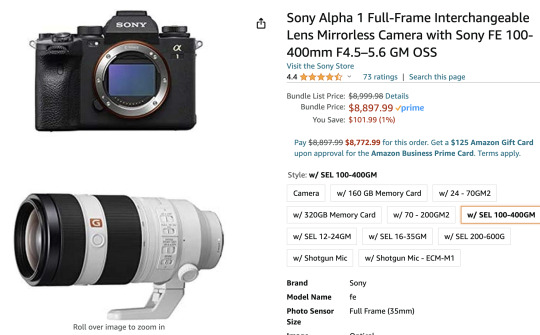
But I'm guessing if you are coming from an Olympus bridge camera that is probably a bit more of an upgrade than you were thinking.
So if easy mode is not viable, let's talk about medium and hard mode.
If you still want the bird detecting autofocus, in body image stabilization, and a pretty zoomy lens, Canon has some newer mirrorless cameras that would take amazing artistic bird shots. It's still spendy, but not $9000 spendy.
The Canon R7 is a great APS-C mirrorless camera with IBIS that can be found used for about $1300. It has 32 megapixels and due to having a slightly smaller sensor, you even get some bonus zoom out of all your lenses at about 1.6x. It's still a much larger sensor than a superzoom, just not quite the size of the Alpha 1.
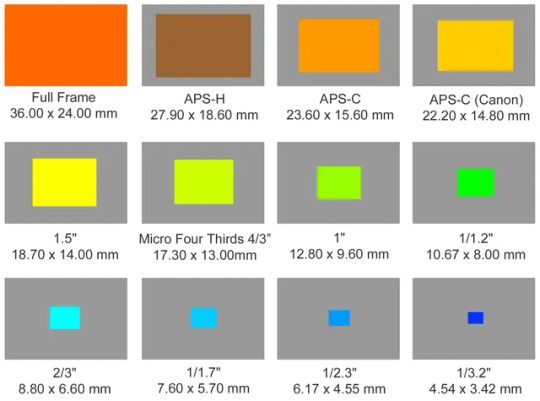
Alpha 1 is Full Frame. R7 is APS-C. And Superzooms don't get any bigger than the 1" sensor.
Pair the R7 with the RF 100-400mm lens ($600 used) with optical stabilization, and you would have a stellar bird photography setup for about $1900. (It would be a 160-640mm equivalent lens on the R7 due to the 1.6x crop factor.)
Which is probably still way more than you want to spend.
So we have the hard mode option.
No bird eye autofocus. No stabilization. You have to learn the fundamentals and practice in order to get good shots. However, wildlife photographers have been getting AMAZING photos with the gear I'm about to suggest. In fact, all of these photos were captured with the hard mode ILC combo.




The Canon 7D Mark II has been a beloved camera body for wildlife photography for many years. Many pros still use it to great effect to this day. It doesn't have bird autofocus, but it still has one of the best DSLR autofocus systems that was ever developed. It can even track moving subjects, it just doesn't know it is tracking a bird so it is more prone to error on occasion. It can be found used for $500-600.
The Canon 400mm F/5.6 telephoto lens is one of the most affordable lenses Canon ever made for wildlife. It is an old lens, but it is sharp and takes beautiful images. No stabilization, but it is big and heavy so that isn't a huge deal. You can also carry a monopod rest it on. And on the 7D II, it is the equivalent of a 640mm lens. It costs around $650 used, which is very inexpensive compared to other telephoto lenses.
So you are looking at around $1200 for the combo. But the photos you can achieve with these two items will blow pretty much any superzoom out of the water.
To sum up...
ILC photography is always going to have a steep learning curve and expensive barrier for entry, but you can achieve some truly stunning results.
Superzooms are getting better and some of the newer ones can still take excellent pictures of birds under the right circumstances. They are lightweight and hassle free and allow you to get incredible zooms for a low cost.
If you mostly take photos of stationary birds outside on bright sunny days, you will be fairly happy with a superzoom.
If you want to take photos during darker times like sunrise or sunset or in a dense forest... or if you want to take photos of birds mid-flight, you will probably have to get an ILC.
I hope that was helpful. I know I overdo these answers, but I try to help as many people as I can by giving a broad overview of the topic and the myriad ways to go about things.
46 notes
·
View notes
Text
Scientists Gingerly Tap into Brain's Power From: USA Today - 10/11/04 - page 1B By: Kevin Maney
Scientists are developing technologies that read brainwave signals and translate them into actions, which could lead to neural prosthetics, among other things. Cyberkinetics Neurotechnology Systems' Braingate is an example of such technology: Braingate has already been deployed in a quadriplegic, allowing him to control a television, open email, and play the computer game Pong using sensors implanted into his brain that feed into a computer. Although "On Intelligence" author Jeff Hawkins praises the Braingate trials as a solid step forward, he cautions that "Hooking your brain up to a machine in a way that the two could communicate rapidly and accurately is still science fiction." Braingate was inspired by research conducted at Brown University by Cyberkinetics founder John Donoghue, who implanted sensors in primate brains that picked up signals as the animals played a computer game by manipulating a mouse; the sensors fed into a computer that looked for patterns in the signals, which were then translated into mathematical models by the research team. Once the computer was trained on these models, the mouse was eliminated from the equation and the monkeys played the game by thought alone. The Braingate interface consists of 100 sensors attached to a contact lens-sized chip that is pressed into the surface of the cerebral cortex; the device can listen to as many as 100 neurons simultaneously, and the readings travel from the chip to a computer through wires. Meanwhile, Duke University researchers have also implanted sensors in primate brains to enable neural control of robotic limbs. The Defense Advanced Research Project Agency (DARPA) is pursuing a less invasive solution by funding research into brain machine interfaces that can read neural signals externally, for such potential applications as thought-controlled flight systems. Practical implementations will not become a reality until the technology is sufficiently cheap, small, and wireless, and then ethical and societal issues must be addressed. Source
7 notes
·
View notes
Text
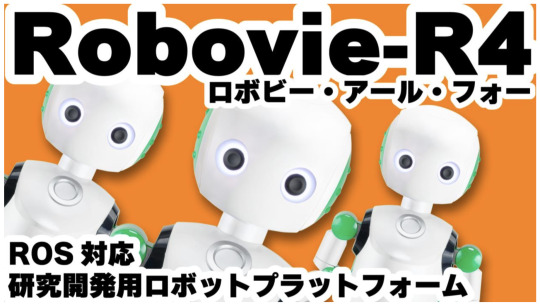


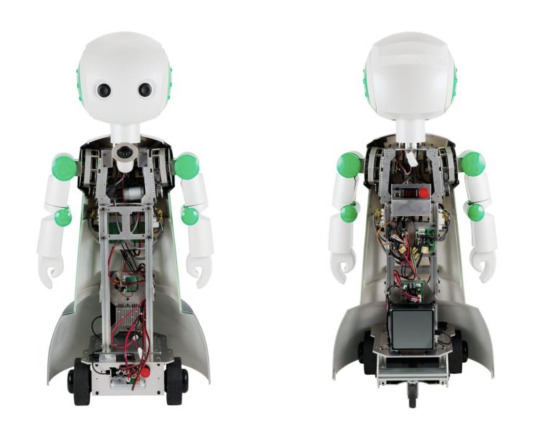

youtube
Robovie-R4 (2022) by ATR and Vstone, Osaka. "Robovie-R4 is a state-of-the-art robot platform for communication research. It combines a humanoid upper body with a robust rover base, enabling smooth and stable navigation in various environments. It also features high expandability, allowing users to customize it with different sensors and devices according to their research objectives. Robovie-R4 supports ROS1 message communication, which facilitates integration and control with other ROS devices. Robovie-R4 is an ideal solution for researchers who want to conduct advanced studies on human-robot interaction." – Vstone.
15 notes
·
View notes
Text
Bossware Surveillance Buildings
A case study on technologies for behavioral monitoring and profiling using motion sensors and wireless networking infrastructure inside offices and other facilities"
Wolfie Christl, Cracked Labs, November 2024
This case study is part of the ongoing project “Surveillance and Digital Control at Work” (2023-2024) led by Cracked Labs, which aims to explore how companies use personal data on workers in Europe, together with AlgorithmWatch, Jeremias Prassl (Oxford), UNI Europa and GPA, funded by the Austrian Arbeiterkammer.
Case study “Tracking Indoor Location, Movement and Desk Occupancy in the Workplace” (PDF, 25 pages) Summary
As offices, buildings and other corporate facilities become networked environments, there is a growing desire among employers to exploit data gathered from their existing digital infrastructure or additional sensors for various purposes. Whether intentionally or as a byproduct, this includes personal data about employees, their movements and behaviors.
Technology vendors are promoting solutions that repurpose an organization’s wireless networking infrastructure as a means to monitor and analyze the indoor movements of employees and others within buildings. While GPS technology is too imprecise to track indoor location, Wi-Fi access points that provide internet connectivity for laptops, smartphones, tables and other networked devices can be used to track the location of these devices. Bluetooth, another wireless technology, can also be used to monitor indoor location. This can involve Wi-Fi access points that track Bluetooth-enabled devices, so-called “beacons” that are installed throughout buildings and Bluetooth-enabled badges carried by employees. In addition, employers can utilize badging systems, security cameras and video conferencing technology installed in meeting rooms for behavioral monitoring, or even environmental sensors that record room temperature, humidity and light intensity. Several technology vendors provide systems that use motion sensors installed under desks or in the ceilings of rooms to track room and desk attendance.
This case study explores software systems and technologies that utilize personal data on employees to monitor room and desk occupancy and track employees’ location and movements inside offices and other corporate facilities. It focuses on the potential implications for employees in Europe. To illustrate wider practices, it investigates systems for occupancy monitoring and indoor location tracking offered by Cisco, Juniper, Spacewell, Locatee and other technology vendors, based on an analysis of technical documentation and other publicly available sources. It briefly addresses how workers resisted the installation of motion sensors by their employers. This summary presents an overview of the findings of this case study….
6 notes
·
View notes
Text

In the realm of the Internet of Things (IoT), a world of limitless possibilities unfolds, transcending boundaries and revolutionizing the way we interact with technology.
#artificial intelligence#iot solutions#iot sensors#iot innovation#IoT-enabled BSM#inventory management
0 notes
Text

NASA tests new ways to stick the landing in challenging terrain
Advancing new hazard detection and precision landing technologies to help future space missions successfully achieve safe and soft landings is a critical area of space research and development, particularly for future crewed missions.
To support this, NASA's Space Technology Mission Directorate (STMD) is pursuing a regular cadence of flight testing on a variety of vehicles, helping researchers rapidly advance these critical systems for missions to the moon, Mars, and beyond.
"These flight tests directly address some of NASA's highest-ranked technology needs, or shortfalls, ranging from advanced guidance algorithms and terrain-relative navigation to lidar-and optical-based hazard detection and mapping," said Dr. John M. Carson III, STMD technical integration manager for precision landing and based at NASA's Johnson Space Center in Houston.
Since the beginning of this year, STMD has supported flight testing of four precision landing and hazard detection technologies from many sectors, including NASA, universities, and commercial industry. These cutting-edge solutions have flown aboard a suborbital rocket system, a high-speed jet, a helicopter, and a rocket-powered lander testbed. That's four precision landing technologies tested on four different flight vehicles in four months.
"By flight testing these technologies on Earth in spaceflight-relevant trajectories and velocities, we're demonstrating their capabilities and validating them with real data for transitioning technologies from the lab into mission applications," said Dr. Carson. "This work also signals to industry and other partners that these capabilities are ready to push beyond NASA and academia and into the next generation of moon and Mars landers."
The following NASA-supported flight tests took place between February and May:
Identifying landmarks to calculate accurate navigation solutions is a key function of Draper's Multi-Environment Navigator (DMEN), a vision-based navigation and hazard detection technology designed to improve safety and precision of lunar landings.
Aboard Blue Origin's New Shepard reusable suborbital rocket system, DMEN collected real-world data and validated its algorithms to advance it for use during the delivery of three NASA payloads as part of NASA's Commercial Lunar Payload Services (CLPS) initiative. On Feb. 4, DMEN performed the latest in a series of tests supported by NASA's Flight Opportunities program, which is managed at NASA's Armstrong Flight Research Center in Edwards, California.
During the February flight, which enabled testing at rocket speeds on ascent and descent, DMEN scanned the Earth below, identifying landmarks to calculate an accurate navigation solution. The technology achieved accuracy levels that helped Draper advance it for use in terrain-relative navigation, which is a key element of landing on other planets.
Several highly dynamic maneuvers and flight paths put Psionic's Space Navigation Doppler Lidar (PSNDL) to the test while it collected navigation data at various altitudes, velocities, and orientations.
Psionic licensed NASA's Navigation Doppler Lidar technology developed at Langley Research Center in Hampton, Virginia, and created its own miniaturized system with improved functionality and component redundancies, making it more rugged for spaceflight.
In February, PSNDL along with a full navigation sensor suite was mounted aboard an F/A-18 Hornet aircraft and underwent flight testing at NASA Armstrong.
The aircraft followed a variety of flight paths over several days, including a large figure-eight loop and several highly dynamic maneuvers over Death Valley, California. During these flights, PSNDL collected navigation data relevant for lunar and Mars entry and descent.
The high-speed flight tests demonstrated the sensor's accuracy and navigation precision in challenging conditions, helping prepare the technology to land robots and astronauts on the moon and Mars. These recent tests complemented previous Flight Opportunities-supported testing aboard a lander testbed to advance earlier versions of their PSNDL prototypes.
Researchers at NASA's Goddard Space Flight Center in Greenbelt, Maryland, developed a state-of-the-art Hazard Detection Lidar (HDL) sensor system to quickly map the surface from a vehicle descending at high speed to find safe landing sites in challenging locations, such as Europa (one of Jupiter's moons), our own moon, Mars, and other planetary bodies throughout the solar system. The HDL-scanning lidar generates three-dimensional digital elevation maps in real time, processing approximately 15 million laser measurements and mapping two football fields' worth of terrain in only two seconds.
In mid-March, researchers tested the HDL from a helicopter at NASA's Kennedy Space Center in Florida, with flights over a lunar-like test field with rocks and craters. The HDL collected numerous scans from several different altitudes and view angles to simulate a range of landing scenarios, generating real-time maps. Preliminary reviews of the data show excellent performance of the HDL system.
The HDL is a component of NASA's Safe and Precise Landing—Integrated Capabilities Evolution (SPLICE) technology suite. The SPLICE descent and landing system integrates multiple component technologies, such as avionics, sensors, and algorithms, to enable landing in hard-to-reach areas of high scientific interest. The HDL team is also continuing to test and further improve the sensor for future flight opportunities and commercial applications.
Providing pinpoint landing guidance capability with minimum propellant usage, the San Diego State University (SDSU) powered-descent guidance algorithms seek to improve autonomous spacecraft precision landing and hazard avoidance.
During a series of flight tests in April and May, supported by NASA's Flight Opportunities program, the university's software was integrated into Astrobotic's Xodiac suborbital rocket-powered lander via hardware developed by Falcon ExoDynamics as part of NASA TechLeap Prize's Nighttime Precision Landing Challenge.
The SDSU algorithms aim to improve landing capabilities by expanding the flexibility and trajectory-shaping ability and enhancing the propellant efficiency of powered-descent guidance systems. They have the potential for infusion into human and robotic missions to the moon as well as high-mass Mars missions.
By advancing these and other important navigation, precision landing, and hazard detection technologies with frequent flight tests, NASA's Space Technology Mission Directorate is prioritizing safe and successful touchdowns in challenging planetary environments for future space missions.
IMAGE: New Shepard booster lands during the flight test on February 4, 2025. Credit: Blue Origin
2 notes
·
View notes
Text
Why do cars in USA have headlights on always?
In the U.S., many cars have headlights on even during daylight hours due to a combination of safety regulations, manufacturer practices, and technological trends. Here’s a detailed breakdown of the reasons:
1. Daytime Running Lights (DRLs) Adoption Voluntary Industry Standard: Unlike Canada and the EU, the U.S. has no federal mandate for DRLs. However, many automakers install them voluntarily to align with global safety trends and reduce collisions . Safety Benefits: Studies show DRLs improve vehicle visibility by 5–15%, reducing daytime accidents. This aligns with safety advocacy in regions like the EU, where DRLs are mandatory . 2. State-Level Regulations Inclement Weather Laws: Most U.S. states require headlights during rain, fog, or low visibility. For example, Delaware mandates headlights when windshield wipers are active . Secondary Offenses: In some states, driving without headlights in poor conditions is a secondary offense, meaning drivers can’t be pulled over solely for this violation but may face penalties if stopped for another reason . 3. Automatic Lighting Systems Consumer Demand for Convenience: Modern cars often feature automatic headlights that activate based on ambient light sensors. Drivers may leave these systems enabled, leading to lights being "always on" unintentionally . Limitations of Auto Mode: Sensors may not activate lights in all required scenarios (e.g., fog or rain), prompting drivers to manually override settings, further normalizing daytime use . 4. Safety Advocacy and Public Awareness Pedestrian Safety: Advocacy groups like the Soft Lights Foundation highlight risks of overly bright LED headlights but also emphasize the need for consistent visibility to protect pedestrians, especially at night . Driver Education: Campaigns stress the importance of headlights for visibility, even during daylight, in mixed traffic or rural areas . 5. Technological and Market Trends LED Efficiency: Advances in LED technology make DRLs energy-efficient and long-lasting, reducing automakers’ reluctance to include them . Adaptive Lighting Challenges: While adaptive beam headlights (e.g., ADB) are common in Europe, U.S. regulations until 2022 restricted their adoption, pushing manufacturers to rely on simpler "always-on" solutions . 6. Cultural Factors Consumer Perception: Many drivers associate "always-on" headlights with modernity or safety, even if not legally required. Social media discussions reveal frustration with drivers who neglect headlights in poor conditions, reinforcing the habit . Key Takeaways Factor Explanation Source DRLs Voluntary adoption by automakers for safety State Laws Mandates during rain/fog; secondary offenses Auto Systems Convenience-driven automatic activation LED Tech Energy efficiency enables daytime use While the U.S. lacks a federal DRL mandate, the convergence of safety priorities, state laws, and technological innovation has normalized "always-on" headlights. For optimal safety, drivers should ensure lights are properly aimed to avoid glare and manually activate them in poor visibility, even if automatic systems lag .

#led lights#car lights#led car light#youtube#led auto light#led headlights#led light#led headlight bulbs#ledlighting#young artist#american cars#cars#car culture#car#classic cars#usa#us politics#us law#headlight bulb#headlamp#headlight#lighting
4 notes
·
View notes
Text

Nano-optical sensors enable structural safety monitoring of buildings with color variations
As buildings age, the demand for effective monitoring of their structural integrity has grown significantly. A breakthrough in nano-optical sensor technology now enables precise, real-time measurement of structural deformation and stability. This innovation promises to reshape the field of structural diagnostics, offering a cost-effective, time-efficient solution that reduces the need for specialized expertise traditionally required in this area. Led by Dr. Jae Sung Yoon, Principal Researcher at the Nano-lithography & Manufacturing Research Center within the Nano-convergence Manufacturing Research Division at the Korea Institute of Machinery and Materials (KIMM), affiliated with the Ministry of Science and ICT, and Ph.D. candidate Nguyen Hoang Minh from the UST-KIMM School, the research team drew inspiration from the structural coloration observed in natural phenomena such as peacock feathers and morpho butterflies.
Read more.
#Materials science#Science#Safety#Color#Structures#Stress and strain#Deformation mechanisms#Structural color
7 notes
·
View notes
Text
Quantum computers:
leverage the principles of **quantum mechanics** (superposition, entanglement, and interference) to solve certain problems exponentially faster than classical computers. While still in early stages, they have transformative potential in multiple fields:
### **1. Cryptography & Cybersecurity**
- **Breaking Encryption**: Shor’s algorithm can factor large numbers quickly, threatening RSA and ECC encryption (forcing a shift to **post-quantum cryptography**).
- **Quantum-Safe Encryption**: Quantum Key Distribution (QKD) enables theoretically unhackable communication (e.g., BB84 protocol).
### **2. Drug Discovery & Material Science**
- **Molecular Simulation**: Modeling quantum interactions in molecules to accelerate drug design (e.g., protein folding, catalyst development).
- **New Materials**: Discovering superconductors, better batteries, or ultra-strong materials.
### **3. Optimization Problems**
- **Logistics & Supply Chains**: Solving complex routing (e.g., traveling salesman problem) for airlines, shipping, or traffic management.
- **Financial Modeling**: Portfolio optimization, risk analysis, and fraud detection.
### **4. Artificial Intelligence & Machine Learning**
- **Quantum Machine Learning (QML)**: Speeding up training for neural networks or solving complex pattern recognition tasks.
- **Faster Data Search**: Grover’s algorithm can search unsorted databases quadratically faster.
### **5. Quantum Chemistry**
- **Precision Chemistry**: Simulating chemical reactions at the quantum level for cleaner energy solutions (e.g., nitrogen fixation, carbon capture).
### **6. Climate & Weather Forecasting**
- **Climate Modeling**: Simulating atmospheric and oceanic systems with higher accuracy.
- **Energy Optimization**: Improving renewable energy grids or fusion reactor designs.
### **7. Quantum Simulations**
- **Fundamental Physics**: Testing theories in high-energy physics (e.g., quark-gluon plasma) or condensed matter systems.
### **8. Financial Services**
- **Option Pricing**: Monte Carlo simulations for derivatives pricing (quantum speedup).
- **Arbitrage Opportunities**: Detecting market inefficiencies faster.
### **9. Aerospace & Engineering**
- **Aerodynamic Design**: Optimizing aircraft shapes or rocket propulsion systems.
- **Quantum Sensors**: Ultra-precise navigation (e.g., GPS-free positioning).
### **10. Breakthroughs in Mathematics**
- **Solving Unsolved Problems**: Faster algorithms for algebraic geometry, topology, or number theory.
#future#cyberpunk aesthetic#futuristic#futuristic city#cyberpunk artist#cyberpunk city#cyberpunkart#concept artist#digital art#digital artist#quantum computers#the future of quantum computers#futuristic theory
5 notes
·
View notes
Text
Why Sabaragamuwa University is a Great Choice.
Sabaragamuwa University of Sri Lanka (SUSL) is increasingly recognized for its technological advancement and innovation-driven environment, making it one of the leading universities in Sri Lanka in terms of technology. Here are the key reasons why SUSL stands out technologically.

Here’s why SUSL stands out as a technological powerhouse among Sri Lankan universities:
🔧1. Faculty of Technology
SUSL established a dedicated Faculty of Technology to meet the demand for tech-skilled graduates. It offers degree programs such as:
BTech in Information and Communication Technology
BTech in Engineering Technology
These programs combine practical experience in labs, workshops and real-world projects with a strong theoretical foundation.
🖥️2. Advanced IT Infrastructure
SUSL has modern computer labs, smart classrooms, and high-speed internet access across campus.
A robust Learning Management System (LMS) supports online learning and hybrid education models.
Students and lecturers use tools like Moodle, Zoom, and Google Classroom effectively.
🤖 3. Innovation & AI Research Support
SUSL promotes AI, Machine Learning, IoT, and Data Science in student research and final-year projects.
Competitions like Hackathons and Innovative Research Symposia encourage tech-driven solutions.
Students develop apps, smart systems, and automation tools (e.g., Ceylon Power Tracker project).
🌐 4. Industry Collaboration and Internships
SUSL connects students with the tech industry through:
Internships at leading tech firms
Workshops led by industry experts
Collaborative R&D projects with government and private sector entities
These connections help students gain hands-on experience in areas such as software engineering, networking, and data analytics that make them highly employable after graduation.
💡 5. Smart Campus Initiatives
SUSL is evolving into a Smart University, introducing systems that streamline academic life:
Digital student portals
Online registration and results systems
E-library and remote resource access
Campus Wi-Fi for academic use
These initiatives improve the student experience and create an efficient, technology-enabled environment.
🎓 6. Research in Emerging Technologies
The university is involved in pioneering research across emerging technological fields, including:
Agricultural tech (AgriTech)
Environmental monitoring using sensors
Renewable energy systems
Students and faculty publish research in international journals and participate in global tech events.
🏆 7. Recognition in National Competitions
SUSL students often reach fina rounds or win national competitions in coding, robotics, AI, and IoT innovation.
Faculty members are invited as tech advisors and conference speakers, reinforcing the university's expertise.
Sabaragamuwa University is actively shaping the future not only with technology, but by integrating technology into education, research and operations. This makes it a technological leader among Sri Lankan Universities. Visit the official university site here: Home | SUSL
2 notes
·
View notes
Text
Technology-Driven Care: From Automated Dialysis to Smart Endoscopy and GI Stenting
With advancements in medical technology reshaping healthcare, innovative solutions are transforming patient care across various specialties. These developments, from automated dialysis systems to smart endoscopy and gastrointestinal (GI) stenting, enhance precision, efficiency, and outcomes for patients worldwide.
Automated Dialysis: Streamlining Renal Care
Automated dialysis systems represent a significant leap in nephrology. These devices minimize human intervention, reducing the risk of errors while optimizing treatment consistency. Patients with chronic kidney disease benefit from personalized therapy adjustments, as the technology continuously monitors vital parameters. These systems improve patient comfort and clinical results by automating fluid removal and dialysis duration.
Smart Endoscopy: Precision in Diagnostics and Treatment
Smart Endoscopy software integrates artificial intelligence (AI) and high-definition imaging to revolutionize gastrointestinal diagnostics. AI algorithms detect abnormalities such as polyps or early-stage cancers with higher accuracy than traditional methods. Physicians receive real-time feedback, enabling quicker decision-making. Additionally, robotic-assisted endoscopy enhances maneuverability in complex procedures, reducing patient discomfort and recovery time.
GI Stenting: Advanced Solutions for Obstruction Relief
Gastrointestinal stenting has evolved with the introduction of smart, self-expanding stents. These devices are designed to open blocked passages in the esophagus, stomach, or intestines, often in patients with malignancies. Modern Esophageal Stents in India incorporate sensors to monitor patency and detect complications like migration or restenosis. This proactive approach allows clinicians to intervene early, improving patient quality of life.
The Future of Technology-Driven Care
As technology advances, its integration into healthcare promises even greater improvements. Interconnected systems, remote monitoring, and AI-driven analytics will further personalize treatment plans. While challenges such as cost and accessibility remain, the potential for technology to enhance patient outcomes is undeniable. Healthcare providers must stay informed to leverage these tools effectively.
Lastly, Automated Peritoneal Dialysis, smart endoscopy, and GI stenting exemplify how technology reshapes modern medicine. These innovations streamline clinical workflows and empower patients with safer, more effective care options.
3 notes
·
View notes